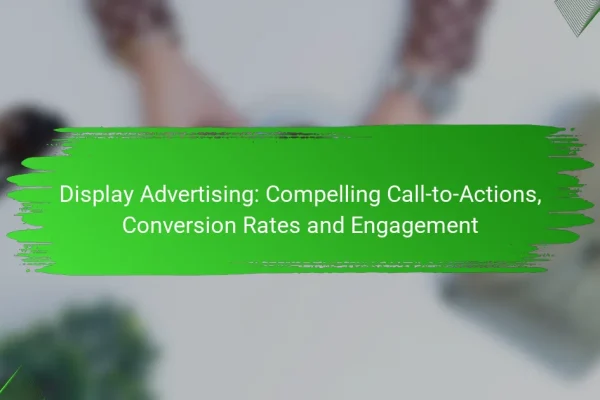What are effective display advertising creative design strategies in New Zealand?
Effective display advertising creative design strategies in New Zealand focus on engaging visuals, responsive layouts, and emotional resonance. These elements help capture attention and drive conversions in a competitive digital landscape.
Visual storytelling techniques
Visual storytelling techniques involve using images, graphics, and layouts to convey a narrative that resonates with the audience. Effective ads often combine visuals with minimal text to create a compelling story that captures attention quickly. For instance, a travel company might use stunning landscape images alongside brief testimonials to evoke wanderlust.
To enhance storytelling, consider using sequential images or animations that guide viewers through a narrative arc. This approach can increase engagement and retention, making the ad more memorable.
Responsive design principles
Responsive design principles ensure that display ads adapt seamlessly to various screen sizes and devices. In New Zealand, where mobile usage is high, ads must look appealing on smartphones, tablets, and desktops alike. A flexible layout that adjusts images and text will improve user experience and click-through rates.
Utilizing fluid grids and scalable images can help maintain visual integrity across devices. Test your designs on multiple platforms to ensure consistency and effectiveness in delivering your message.
Emotional appeal in ads
Emotional appeal in ads taps into the audience’s feelings to create a connection with the brand. Ads that evoke emotions such as happiness, nostalgia, or empathy are more likely to resonate and drive action. For example, a charity might use heartfelt stories of individuals impacted by their work to encourage donations.
To effectively incorporate emotional appeal, identify the core emotions you want to evoke and align your visuals and messaging accordingly. Avoid clichés; instead, aim for authentic narratives that reflect real experiences.
Brand consistency practices
Brand consistency practices ensure that all display ads reflect the same visual identity and messaging. This includes using consistent colors, fonts, and logos across all advertising materials. In New Zealand, maintaining a cohesive brand image helps build trust and recognition among consumers.
Develop a style guide that outlines your brand’s visual elements and messaging tone. Regularly review your ads to ensure they align with this guide, reinforcing brand identity in every interaction.
Use of color psychology
The use of color psychology in display advertising can significantly influence consumer behavior. Different colors evoke specific emotions; for instance, blue often conveys trust, while red can create a sense of urgency. In New Zealand, understanding cultural associations with colors can enhance ad effectiveness.
When designing ads, choose colors that align with your brand message and the emotions you want to evoke. Test different color combinations to see which resonate best with your target audience, and adjust based on feedback and performance metrics.
How to optimize display advertising creatives for performance?
To optimize display advertising creatives for performance, focus on clarity, relevance, and visual appeal. Effective creatives should resonate with the target audience, convey a clear message, and include strong calls to action.
A/B testing methodologies
A/B testing involves comparing two versions of an ad to determine which performs better. This can include variations in design, messaging, or placement. Run tests over a sufficient duration to gather meaningful data, ideally targeting a sample size that reflects your audience.
Consider testing one element at a time, such as the headline or image, to isolate the impact of each change. Use tools like Google Optimize or Optimizely for streamlined testing processes.
Analytics tools for performance tracking
Utilizing analytics tools is essential for tracking the performance of display ads. Google Analytics, Adobe Analytics, and Facebook Ads Manager provide insights into user engagement, click-through rates, and conversion metrics.
Set up conversion tracking to measure specific actions taken by users after interacting with your ads. This data helps refine future campaigns and improve overall performance.
Key performance indicators to measure
Key performance indicators (KPIs) for display advertising include click-through rate (CTR), conversion rate, and return on ad spend (ROAS). Monitoring these metrics helps assess the effectiveness of your creatives.
For example, a CTR of 0.5% to 2% is generally considered average, while a conversion rate of 2% to 5% is often seen as successful. Regularly review these KPIs to make informed adjustments to your advertising strategy.
What are the best tools for display advertising creative design?
The best tools for display advertising creative design include user-friendly platforms like Canva, professional software such as Adobe Creative Suite, and specialized tools like Google Web Designer. Each tool offers unique features that cater to different skill levels and project requirements.
Canva for design
Canva is an accessible design tool ideal for beginners and marketers who need to create visually appealing ads quickly. It offers a wide range of templates, images, and design elements that simplify the creative process.
With its drag-and-drop interface, users can easily customize designs without needing extensive graphic design skills. Canva also provides collaboration features, allowing teams to work together in real-time on projects.
Adobe Creative Suite for professionals
Adobe Creative Suite is a comprehensive set of professional design tools, including Photoshop, Illustrator, and InDesign, suited for experienced designers. These applications offer advanced features for creating high-quality graphics and animations for display ads.
While the learning curve can be steep, the flexibility and precision of Adobe tools enable designers to produce unique and intricate designs. Professionals often use Adobe for projects that require detailed customization and brand consistency.
Google Web Designer for HTML5 ads
Google Web Designer is a free tool specifically designed for creating HTML5 ads, making it a great choice for developers and marketers focused on interactive content. It allows users to build responsive ads that work seamlessly across devices.
This tool supports animation and offers a visual interface, making it easier to design complex layouts without extensive coding knowledge. Google Web Designer also integrates well with Google Ads, streamlining the ad deployment process.
What are the common mistakes in display advertising creative design?
Common mistakes in display advertising creative design include overcrowded visuals, poor call-to-action placement, and ignoring target audience preferences. These errors can significantly reduce the effectiveness of ads and lead to lower engagement and conversion rates.
Overcrowded visuals
Overcrowded visuals can overwhelm viewers, making it difficult for them to focus on the main message. A cluttered design often leads to confusion and can dilute the intended impact of the advertisement. Aim for simplicity by using a limited color palette and clear imagery.
To avoid overcrowding, prioritize essential elements. Use white space strategically to guide the viewer’s eye and highlight key information. A good rule of thumb is to limit the number of visual elements to three or four main components.
Poor call-to-action placement
Poor call-to-action (CTA) placement can hinder user engagement and reduce conversion rates. If the CTA is not prominently displayed or is placed in an unexpected location, users may overlook it entirely. Ensure that the CTA stands out through size, color, and positioning.
Position the CTA where it naturally fits within the flow of the ad, typically near the center or bottom. Use action-oriented language that clearly communicates what the user should do next, such as “Shop Now” or “Learn More.” Testing different placements can help identify the most effective option.
Ignoring target audience preferences
Ignoring target audience preferences can lead to ineffective advertising that fails to resonate with viewers. Understanding the demographics, interests, and behaviors of your audience is crucial for creating relevant and appealing designs. Tailor visuals and messaging to align with audience expectations.
Conduct market research to gather insights about your target audience. Consider factors such as age, gender, and cultural background when designing ads. Engaging with your audience through surveys or social media can also provide valuable feedback to refine your creative approach.
What are the latest trends in display advertising creative design?
The latest trends in display advertising creative design focus on personalization, interactivity, and the use of rich media. Advertisers are increasingly leveraging data to create tailored experiences that resonate with specific audiences, enhancing engagement and conversion rates.
Personalization in Display Advertising
Personalization involves customizing ad content based on user behavior, preferences, and demographics. This approach can significantly improve click-through rates and overall effectiveness. For instance, using dynamic content that changes based on user data can lead to more relevant ads that capture attention.
To implement personalization effectively, consider utilizing data analytics tools to gather insights about your audience. Ensure that your creative design reflects these insights, such as using localized imagery or language that resonates with specific groups.
Interactive Ad Formats
Interactive ads encourage user participation, making them more engaging than traditional static formats. Examples include polls, quizzes, and games that invite users to interact with the ad content. This engagement can lead to higher retention and brand recall.
When designing interactive ads, focus on simplicity and clarity. Ensure that the interaction is intuitive and does not overwhelm the user. A well-designed interactive element can enhance user experience and drive conversions.
Use of Rich Media
Rich media ads incorporate advanced features like video, audio, and animation to create a more immersive experience. These formats can capture attention more effectively than standard display ads, often leading to higher engagement rates.
Consider using rich media strategically, as they can be more expensive to produce. Balance the creative investment with expected returns by testing different formats and analyzing performance metrics to determine what resonates best with your audience.











